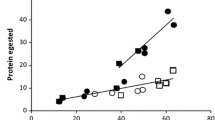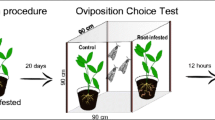Summary
Defoliated ragwort plants produced regrowth foliage that was higher in alkaloid, but lower in amino acid concentrations than primary foliage. Total N was not affected. 2) Plants fertilized with nitrogen (as ammonium sulphate) had lower amino acid concentrations than unfertilized control plants, slightly increased alkaloid levels but similar total N concentrations. 3) Ovipositing females laid eggs upon plants with equal probability for controls, regrowth and fertilized foliage (one rosette in 5 received an egg batch). However, the probability of receiving eggs was significantly lower on the primary leaves of ‘cut-back’ plants that had had their lower leaves removed a few days before egg laying (only one rosette in 13 was selected). 4) Egg batch size was higher on fertilized control foliage than on other treatments. 5) Larvae attained greater final weights when fed a diet of regrowth foliage, despite the higher levels of alkaloid they contained. Larval development rate was not affected by experimental treatment of the foliage. 6) Larval growth was lowest on the leaves of fertilized plants. This was associated with significant reductions in the concentrations of three amino acids (methionine down 29%, tyrosine 33% and lysine 25%).
Similar content being viewed by others
References
Bradstreet RB (1965) The Kjeldahl Method for Organic Nitrogen. Academic Press, New York
Crawley MJ, Nachapong M (1984) Facultative defences and specialist herbivores? Cinnabar moth (Tyria jacobaeae) on the regrowth foliage of ragwort (Senecio jacobaea). Ecol Entomol 9:389–393
Danell K, Huss-Danell K, Bergstrom R (1985) Interactions between browsing moose and two species of birch in Sweden. Ecology 66:1867–1878
Dempster JP (1982) The ecology of the cinnabar moth Tyria jacobaeae L. (Lepidoptera, Arctiidae). Adv Ecol Res 12:1–36
Emden HF van, Bashford MA (1971) The performance of Brevicoryne brassicae and Myzus persicae in relation to plant age and leaf amino acids. Entomol Exp Appl 14:349–360
Fowler SV, Lawton JH (1985) Rapidly induced defences and talking trees: the devil's advocate position. Am Nat 126:181–195
Harborne JB (1973) Phytochemical Methods. Chapman & Hall, London
Hill RL (1982) The phytophagous fauna of gorse (Ulex europeus L.) and host plant quality. Unpublished PhD Thesis. University of London
Kowalski R, Visser PE (1987) Changes of free amino acids in the leaves of Triticum aestivum and their implications for the assessment of plant/insect interactions. J Plant Dis Prot 94:161–168
Leather SR, Watt AD, Forrest GI (1987) Insect-induced chemical changes in young lodgepole pine (Pinus contorta): the effects of previous defoliation on oviposition, growth and survival of the pine beauty moth, Panolis flammea. Ecol Entomol 12:275–281
McNeill S, Southwood TRE (1978) The role of nitrogen in the development of insect/plant relationships. In: Harborne JB (ed) Biochemical Aspects of Plant and Animal Coevolution. Acad Press London, pp 77–98
Meijden E van der, Bemmelen M van, Kooi R, Post BJ (1984) Nutritional quality and chemical defence in the ragwort-cinnabar moth interaction. J Anim Ecol 53:443–453
Mittler TE (1970) Effects of dietary amino acids on the feeding rate of the aphid Myzus persicae. Entomol Exp Appl 13:432–437
Myers JH (1985) Effects of physiological condition of the host plant on the ovipositional choise of the cabbage white butterfly, Pieris rapae. J Anim Ecol 54:193–204
Myers JH, Post BJ (1981) Plant nitrogen and fluctuations of insect populations: a test with the cinnabar moth — tansy ragwort system. Oecologia 48:151–156
Niemela P, Tuomi J, Mannila R, Ojala P (1984) The effect of previous damage on the quality of Scots pine foliage as food for diprionid sawflies. Z Angew Entomol 98:33–42
Prestidge RA, McNeill S (1981) The role of nitrogen in the ecology of grassland Auchenorrhyncha. In: Lee JA, McNeill S, Rorison IH (eds) Nitrogen as an Ecological Factor. pp 257–281. Blackwell Scientific Publications, Oxford
Pullin AS (1987) Changes in leaf quality following clipping and regrowth of Urtica dioica, and consequences for a specialist insect herbivore, Aglais urticae. Oikos 49:39–45
Rhoades DF (1979) Evolution of chemical defence against herbivores. In: Rosenthal GA, Janzen DH (eds) Herbivores: Their Interaction with Secondary Plant Metabolites. Academic Press, New York, pp 3–54
Robinson T (1979) The evolutionary ecology of alkaloids. In: Rosenthal GA, Janzen DH (eds) Herbivores: Their Interaction with Secondary Plant Metabolites. Academic Press, New York, pp 413–448
Rothschild M, Aplin RT, Cockrum PA, Edgar JA, Fairweather P, Lees R (1979) Pyrrolizidine alkaloids in arctiid moths (Lep.) with a discussion on host plant relationships and the role of these secondary plant substances in the Arctiidae. Biol J Linn Soc 12:305–326
Schultz JC, Baldwin TT (1982) Oak leaf quality declines in response to defoliation by gypsy moth larvae. Science 217:149–151
Warren FL (1970) Senecio alkaloids. In: Manske RHF (ed) The Alkaloids. Academic Press, New York, vol 12:246–331
Author information
Authors and Affiliations
Rights and permissions
About this article
Cite this article
Wilcox, A., Crawley, M.J. The effects of host plant defoliation and fertilizer application on larval growth and oviposition behaviour in cinnabar moth. Oecologia 76, 283–287 (1988). https://doi.org/10.1007/BF00379964
Received:
Issue Date:
DOI: https://doi.org/10.1007/BF00379964




